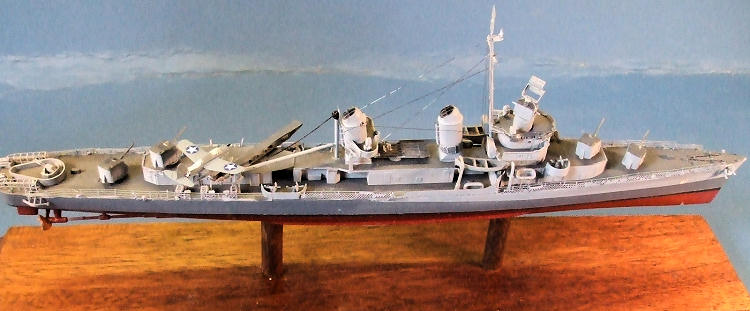
Destroyers and Seaplanes
| KIT #: | 78012 |
| PRICE: | $39.00 SRP |
| DECALS: | options |
| REVIEWER: | Joe Lyons |
| NOTES: |
After-Market: Trumpeter 1:350 scale OS2U Kingfisher (Item No. 06249),Tom’s Model Works Fletcher Class Destroyer Detail Set 1/350 Scale Set #3508,Tom’s Model Works US Light Cruiser Cranes and Catapults 1/350 Scale Set #3507 |

| HISTORY |
All of the major navies of WW II went to considerable effort to operate seaplanes and flying boats off non-aviation ships (non-carriers and non-seaplane tenders). The desire to take these planes to sea significantly impacted the design of battleships and cruisers throughout the early part of the century because of the belief that these aircraft were going to be force multipliers in the great daylight shoot-outs between opposing battle lines that all expected to be the centerpiece of naval warfare.
USN interest in spreading aviation assets to destroyers began in 1922. USS Charles Ausburn (DD-294), a four-stacker, embarked a seaplane (TS-1) for a short period to explore the concept.
“…a Curtiss TS-1 was placed on a cradle forward of the bridge [DD-294]. The two-float fighter was to lower into the water and retrieved by a crane.”
[Larkins]
Interest in the concept was revived in 1940 in response to a
perceived need to bring aircraft into the scouting forces.
“A variation on the basic type [Fletcher class DD] was
the aircraft-carrying destroyer. The failure of the 3500-ton “flotilla
leader”…led to a series of alternate proposals for bringing aircraft in to the
scouting forces, including a catapult on a
Fletcher-class destroyer. On
[Friedman]
By late 1942 the USN and IJN had lost between them ten aircraft carriers and although the USN had in hand major building programs, it would be awhile before new ships arrived. Also, there would never be enough carriers even in the best of times (it was thought) to provide anti-submarine protection to every group of ships that needed it. The catapult destroyers may have been seen as a way to get air coverage on the cheap. OS2Us had earlier found their way to naval district-controlled seaplane bases along the Atlantic coast in the immediate pre-war years. They were a cheap alternative to the big flying boats for coverage of sea-lanes near major ports.
The Ships.
The Fletcher-class DDs were to be built in greater numbers (175)
than any other class of DD in any Navy. The culmination of USN destroyer
development throughout the 1930s, this class by going to a hitherto unacceptably
high displacement combined all the navy’s desired characteristics in gun and
torped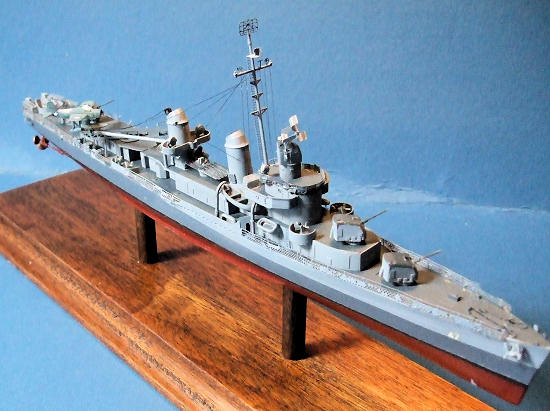 o power, range and most important, growth potential. It easily absorbed
more guns (20mm and 40mm) and electronics as the war progressed, perhaps the
best example being the catapult destroyers themselves. After conversion, they
still possessed as many torpedoes, 5” guns, 40mm guns, and 20 mm guns as most of
the preceding classes after their wartime upgrades. Six of the “early” Fletchers
were tapped for catapult conversion: three actually got it (Pringle, Stevens and Halford). The equipment was removed from all three by October 1943.
o power, range and most important, growth potential. It easily absorbed
more guns (20mm and 40mm) and electronics as the war progressed, perhaps the
best example being the catapult destroyers themselves. After conversion, they
still possessed as many torpedoes, 5” guns, 40mm guns, and 20 mm guns as most of
the preceding classes after their wartime upgrades. Six of the “early” Fletchers
were tapped for catapult conversion: three actually got it (Pringle, Stevens and Halford). The equipment was removed from all three by October 1943.
USS Pringle (DD-477) is replicated for this article. Pringle was built by
Charleston NSY (launched on
Catapult
Conversion-equipment removed:
Mount 53 5”38 gun mount (the 5” guns were numbered from 1-5 as built, from fore to aft, the number “5” signifying the size of the gun)
 After deck house between Mounts 53 and 54
After deck house between Mounts 53 and 54
Torpedo tubes aft of #2 stack
After torpedo handling crane
40mm twin gun and associated Mk 51 director from after deckhouse to fantail aft of Mt 55 (now Mt 54).
A4 catapult (turntable about where Mt 53 had been located)
Aircraft handling kingpost and boom, with kingpost on the centerline aft of #2 stack.
Aircraft handling winch to position the boom and hoist the seaplane. Located on the port side of #2 stack on a platform extended out from the 01 level provided for this purpose. [In USN parlance any ‘deck’ above the main strength deck and hence not in the load-bearing hull structure is considered ‘superstructure’ and the horizontal ‘decks’ therein are called ‘levels, ’numbered in ascending order.]
An examination of photos of Halford, Stevens and Pringle shows that the first two had cranes similar to cruisers and battleships rather than the kingpost-boom arrangement on Pringle
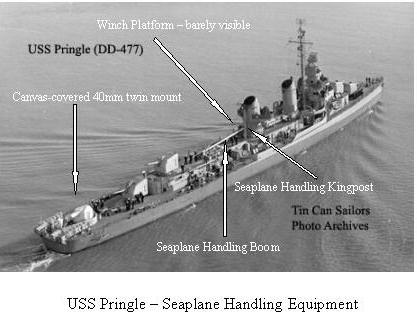 Fuel and lube oil tanks (note: references are
vague as to where these were placed, but the main deck is inferred, possibly in
the now-redundant upper handling room for mount 53). The installation also
infers pump(s), filters, pipelines, valves, etc, to support fueling operations.
Fuel and lube oil tanks (note: references are
vague as to where these were placed, but the main deck is inferred, possibly in
the now-redundant upper handling room for mount 53). The installation also
infers pump(s), filters, pipelines, valves, etc, to support fueling operations.
Provision for stowage and handling of aviation ordnance (most probably 100 lb bombs and depth charges).
The A4 catapult used compressed air rather than the powder charge of the more common P Mk 6 found on cruisers and battleships. This motive power infers large air flasks to hold a charge and possibly an additionally HP air compressor, with associated piping and valves.
USS
Leutze (DD-481) was one of the original six intended
for conversion. She too had a busy war, being inter alia, damaged by shore
batteries at
Pringle commissioned in late 1942 and conducted
flight operations on one convoy escort assignment in the 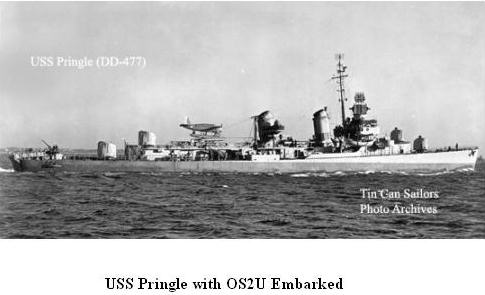 , being struck by kamikazes on two occasions. The last, on
, being struck by kamikazes on two occasions. The last, on
Stevens alone of the three operated a Kingfisher operationally in the pacific for any significant period of time.
Clearly, the availability of many Kaiser-built CVEs eliminated the need for this type of aircraft platform, but past that the destroyer seaplane carrier was an accident waiting to happen, IMHO a BIG accident, if only because of all that unprotected avgas above the waterline. Makes me shudder just to think about it.
Other issues with this type of aviation platform:
Minimal a/c maintenance facilities.
Inability, IMHO, to fire the after 5” guns (most certainly Mt 53) forward of the beam
without blast damage to an aircraft on the catapult
The afore-mentioned handling issues on such a lively platform.
All the catapult destroyers operated the Vought OS2U Kingfisher.
| THE KIT |
Tamiya kit (78012) was used for Pringle, that being the 1/350 release of DD-445, USS Fletcher, the name ship of the class. An examination of various photos shows, as expected, minor variations among the early member of the class. But the kit does a good job for the chosen ship, which is photographically well documented.
| CONSTRUCTION |
The kit was upgraded/modified from O.O.B. as follows:
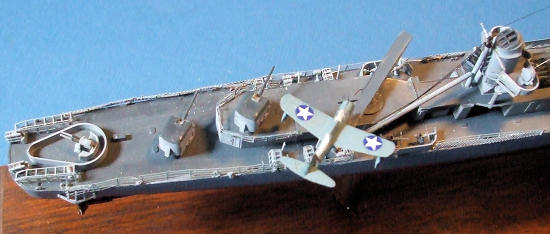 Kit parts not used
Kit parts not used
B5 – 40mm gun platform
B3/B4 – after deck house
D6/D8/D9/D10/D11/ D12 – 5”38 gun (Mt 53)
C11/C12/C13 – after torpedo tubes
Additional kit part used
B8- teardrop shaped 40mm gun shield mounted
between the depth charge racks. This part does not appear in the kit
instructions, but it does allow one of the 40mm variations in the early
Fletchers, including Pringle.
Photo-Etch parts added
Toms’ Modelworks Upgrade for 1/350 Fletcher’s.
Tom’s Modelworks Upgrade for 1/350
Trumpeter 1:350 OS2U
Kingfisher
 Scratch built parts
Scratch built parts
Aircraft handling kingpost and boom – brass tubing and rod
Aircraft handling winch – Sheet plastic, rod and fuse wire
Winch/boom cabling – .012 steel wire
Card stock for catapult and handling winch decks
SG radar antenna and platform on the mast (not provided in the kit nor by Tom’s Modelworks
| COLORS & MARKINGS |
Pringle was painted in Measure 22 colors of Navy
Blue (5-N), Haze Gray (5-H) and Deck Blue (20-B). The hull was painted in Navy
blue to the level of the main deck at its lowest point. All other vertical
surfaces were painted Haze Gray. All horizontal surfaces were painted Deck Blue.
Paints used were Model Master Acryl (Navy Blue and Deck Blue) and Polly Scale
(Haze Gray).
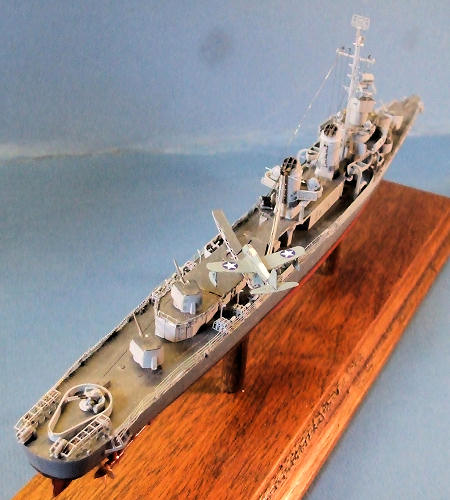 Underwater hull colors: Humbrol Fitting Copper, Floquil
Anti-Fouling Oxide Red, and Polly Scale Black. The kit decal sheet provided the
hull number.
Underwater hull colors: Humbrol Fitting Copper, Floquil
Anti-Fouling Oxide Red, and Polly Scale Black. The kit decal sheet provided the
hull number.
OS2U markings: Yankee Modelworks 350-1001-5 “CV-5 1940-1942 Extra Markings”
| CONCLUSIONS |
The Tamiya kit is very good, with modeling and parts fit we are used to from the manufacturer. It is not excellent.
Within the molding capabilities of injection plastic are in my opinion, such omitted parts as the SG radar and its platform, compass peloruses on the bridge wings and on the centerline of the searchlight on #2 stack (secondary conn) and torpedo directors in the bridge wings. Also missing, and prominently displayed on the kit box top painting are three bridge wing supports. I corrected some but not all of these omissions.
| REFERENCES |
Friedman, N (1982).
Larkins, W.T. (1996). Battleship and Cruiser Aircraft of the
Morison, S.E. (1975). History of
Raven, A (1986). Fletcher Class Destroyers.
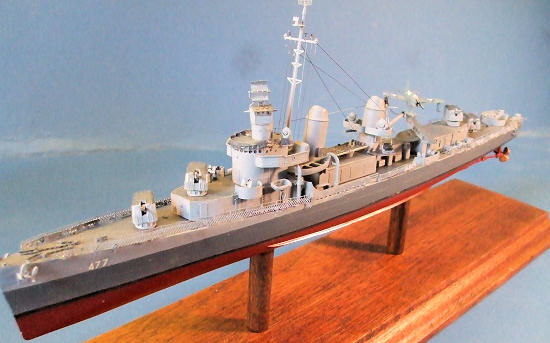 Ross, A. (1988).
The Destroyer The Sullivans [Anatomy
of the Ship series).
Ross, A. (1988).
The Destroyer The Sullivans [Anatomy
of the Ship series).
Solwinski, L, Walkowiak, T. (1976).
June 2009
Copyright ModelingMadness.com
If you would like your product reviewed fairly and quickly, please contact the editor or see other details in the Note to Contributors.